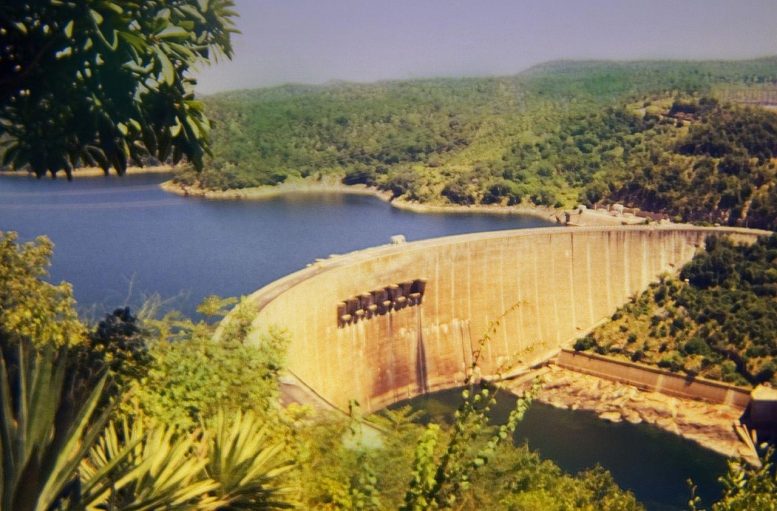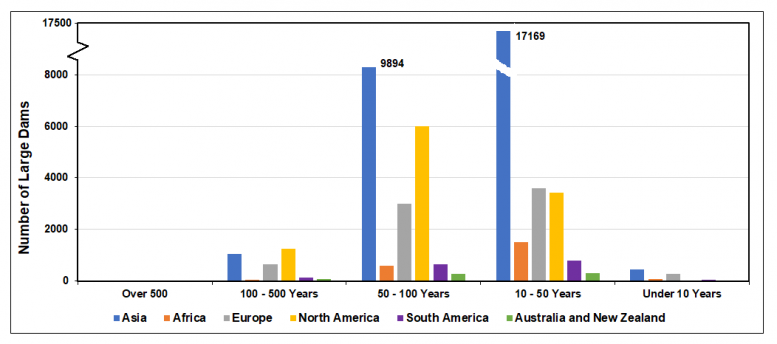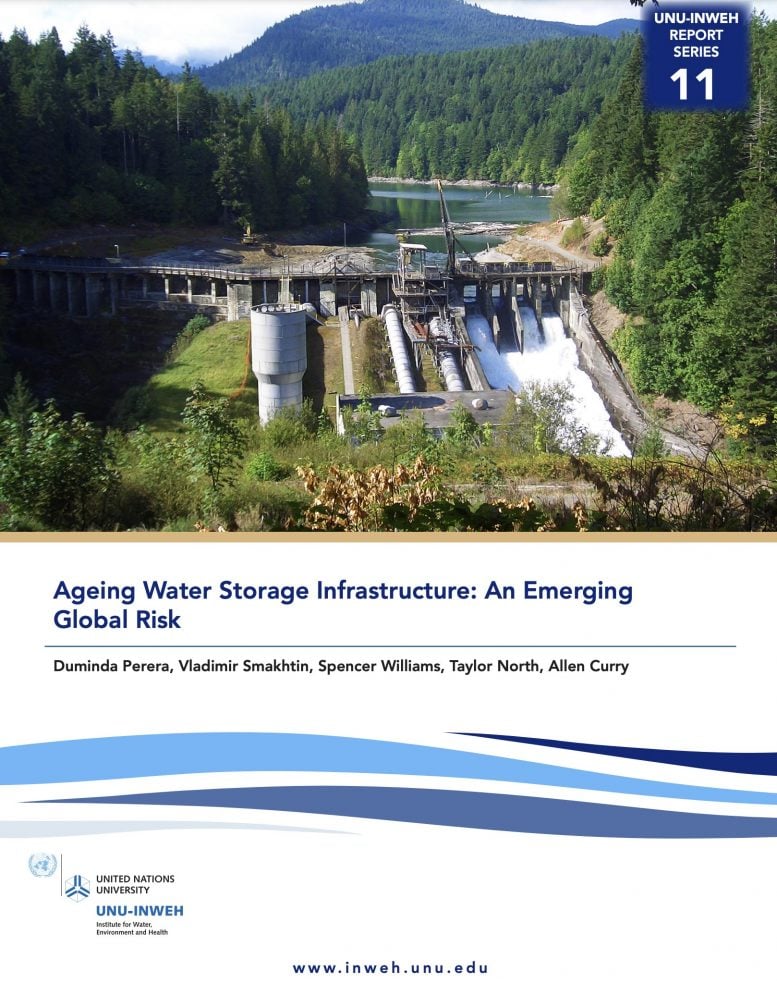
Among the report’s case studies: Africa’s Kariba Dam, the world’s largest man-made reservoir, impounding 181 km³ of water. Almost $300 million was loaned in 2014 to repair the dam, with completion expected by 2023. The report says “Dams like Kariba will likely continue to operate much longer with recurring investments into repairs despite advanced age as they may be simply too large, risky, and costly to remove.” Credit: Rhys Jones
By 2050, most of humanity will live downstream of large dams built in the 20th century; Increasingly expensive to maintain, experts foresee a trend to decommissioning dams.
By 2050, most people on Earth will live downstream of tens of thousands of large dams built in the 20th century, many of them already operating at or beyond their design life, according to a UN University analysis.
The report, “Ageing water infrastructure: An emerging global risk,” by UNU’s Canadian-based Institute for Water, Environment and Health, says most of the 58,700 large dams worldwide were constructed between 1930 and 1970 with a design life of 50 to 100 years, adding that at 50 years a large concrete dam “would most probably begin to express signs of aging.”
Aging signs include increasing cases of dam failures, progressively increasing costs of dam repair and maintenance, increasing reservoir sedimentation, and loss of a dam’s functionality and effectiveness, “strongly interconnected” manifestations, the paper says.
The report says dams that are well designed, constructed, and maintained can “easily” reach 100 years of service but predicts an increase in “decommissioning” — a phenomenon gaining pace in the USA and Europe — as economic and practical limitations prevent aging dams from being upgraded or if their original use is now obsolete.

The problem of aging large dams today confronts a relatively small number of countries — 93% of all the world’s large dams are located in just 25 nations led by China and the USA. Credit: UNU-INWEH
Worldwide, the huge volume of water stored behind large dams is estimated at 7,000 to 8,300 cubic kilometers (1,700 to 2,000 cubic miles) — enough to cover about 80% of Canada’s landmass under a meter of water.
The report provides an overview of dam aging by world region and primary function — water supply, irrigation, flood control, hydropower, and recreation.
It also details the increasing risk of older dams, the rising maintenance expense, the declining functionality due to sedimentation, the benefits of restoring or redesigning natural environments, and the societal impacts — pro and con — that need to be weighed by policymakers deciding what to do. Notably, “the nature of these impacts varies significantly between low- and high-income countries.”
The analysis also includes dam decommissioning or aging case studies from the USA, France, Canada, India, Japan, and Zambia & Zimbabwe.
Climate change will accelerate the dam aging process
“This report aims to attract global attention to the creeping issue of aging water storage infrastructure and stimulate international efforts to deal with this emerging, rising water risk,” says co-author Vladimir Smakhtin, Director of UNU-INWEH.
“Underlined is the fact that the rising frequency and severity of flooding and other extreme environmental events can overwhelm a dam’s design limits and accelerate a dam’s aging process. Decisions about decommissioning, therefore, need to be taken in the context of a changing climate.”
Notes lead author and UNU-INWEH Senior Researcher Duminda Perera: “This problem of aging large dams today confronts a relatively small number of countries — 93% of all the world’s large dams are located in just 25 nations.”
“Large dam construction surged in the mid-20th century and peaked in the 1960s – 70s,” he says, “especially in Asia, Europe, and North America, while in Africa the peak occurred in the 1980s. The number of newly-constructed large dams after that continuously and progressively declined.”
According to the report, the world is unlikely to witness another large dam-building revolution as in the mid-20th century, but dams constructed then will inevitably be showing their age.
China has 23,841 large dams (40% of the world’s total). And 32,716 large dams (55% of the world’s total) are found in just four Asian countries: China, India, Japan, and the Republic of Korea — a majority of which will reach the 50-year threshold relatively soon. The same is true of many large dams in Africa, South America, and Eastern Europe.
The pace of large dam construction has dropped dramatically in the last four decades and continues to decline in part because “the best locations for such dams globally have been progressively diminishing as nearly 50% of global river volume is already fragmented or regulated by dams,” the report says.
As well, there are strong concerns regarding the environmental and social impacts of dams, and large dams in particular, as well as emerging ideas and practices on the alternative types of water storage, nature-based solutions, and types of energy production beyond hydropower.
Drivers of dam decommissioning
Public safety, escalating maintenance costs, reservoir sedimentation, and restoration of a natural river ecosystem are among the reasons driving dam decommissioning.
However, most dams removed to date have been small; decommissioning large dams (defined by ICOLD as 15 or more meters from lowest foundation to crest, or 5 to 15 meters impounding more than 3 million cubic meters) is “still in its infancy, with only a few known cases in the last decade.”
“A few case studies of aging and decommissioned large dams illustrate the complexity and length of the process that is often necessary to orchestrate the dam removal safely,” adds co-author and UNU-INWEH Adjunct Professor R. Allen Curry, based at the University of New Brunswick.
“Even removing a small dam requires years (often decades) of continuous expert and public involvement, and lengthy regulatory reviews. With the mass aging of dams well underway, it is important to develop a framework of protocols that will guide and accelerate the dam removal process.”
Decommissioning will also have various positive and negative economic, social, and ecological impacts to be considered in a local and regional social, economic, and geographic context “critical to protect the broader, sustainable development objectives for a region,” the report says.
“Overall, dam decommissioning should be seen as equally important as dam building in the overall planning process on water storage infrastructure developments.”
“Ultimately, value judgments will determine the fate of many of these large water storage structures. It is not an easy process, and thus distilling lessons from and sharing dam decommissioning experiences should be a common global goal. Lack of such knowledge and lack of its reflection in relevant regional/national policies/practices may progressively and adversely affect the ability to manage water storage infrastructure properly as it is aging.”
In addition to the three UNU-INWEH experts, the report was co-authored by Spencer Williams, Graduate Institute of International and Development Studies, Geneva, Switzerland. and Taylor North of McMaster University, Hamilton, Canada.
By the numbers
General
- 58,700: large dams registered in the International Commission on Large Dams (ICOLD) database, a large dam is defined as 15+ meters in height, measured from lowest foundation to crest, or 5 to 15 meters high impounding more than 3 million cubic meters (0.003 km³). Within the 58,700 large dam total, roughly one in eight has a 100 million cubic meter (0.1 km³) capacity
- 7,000 to 8,300 km³: volume of water stored behind large dams worldwide — about one-sixth of all river discharge worldwide each year — enough to cover roughly 80% of Canada’s landmass under a meter of water
- 50 to 100 years: design life of dams constructed between 1930 and 1970 (when most existing large dams were built). Average life expectancy: 50 years
- ~16,000: large dams 50 to 100 years old in North America and Asia
- ~2,300: large dams 100+ years old in North America and Asia
USA / Canada
- 56: average age of 90,580 US dams (all sizes)
- 85%+: US dams in 2020 operating at or beyond their life expectancy
- 75%: US dam failures that occurred after 50 years of age
- US$ 64 billion: estimated cost to refurbish US dams
- 1,275: dams removed in 21 US states in the last 30 years; 80 removed in 2017 alone
- 50%+: large dams in Canada over 50 years old
Asia / Pacific
China
- 56%: proportion of the world’s large dams located in China and the US (the top 25 countries account for more than ~93%)
- 23,841: large dams in China (the most of any country, and 40% of the world’s total
- 60%: proportion of the world’s large dams in Asia
- 55%: proportion of the world’s large dams in just four countries — China, India, Japan, and the Republic of Korea — the majority of which will soon reach 50 years of age
India
- 1,115+: large dams in India that will be roughly 50 years old in 2025
- 4,250+: large dams in India that will be 50+ years old in 2050
- 64: large dams in India that will be 150+ years old in 2050
- 3.5 million: the approximate number of people at risk if India’s Mullaperiyar dam, built 100+ years ago, were to fail. The dam, in a seismically active area, shows significant structural flaws and its management is a contentious issue between Kerala and Tamil Nadu States
Japan
- 100+ years: average age of large dams in Japan
Australia
- 650: large dams in Australia, half of them 50+ years old; 50+ have been in operation for 100+ years. Portion of Australia’s electricity generation from hydropower: 65%
UK / Europe
- 100+ years: average age of large dams in the UK
- ~10%: large dams in Europe 100+ years old
Africa
- 2,000: large dams in Africa (¼ of them in South Africa), the fewest of any continent; mostly used for irrigation
UNU-INWEH is supported by the Government of Canada through Global Affairs Canada, and hosted by McMaster University, Hamilton, Canada.










“Most of humanity is at risk” …. Our sincerest thanks to the UN for adding another existential crisis to the growing list that includes overpopulation, climate change, rising sea levels, proliferating bioweapons, pandemics, nuclear war, asteroid impact, wandering black holes, resource depletion, and not to forget fiat currencies and the satanic pedophiles running all the Western democracies. Anyone see a pattern here?
Richie
To add to the concerns, the decommissioning of a large number of dams will contribute to sea level rise, and require diesel fuel (CO2!) for earth-moving equipment. They will leave behind scars for several years and people who previously boated and fished on the reservoirs will have to find other forms of recreation.